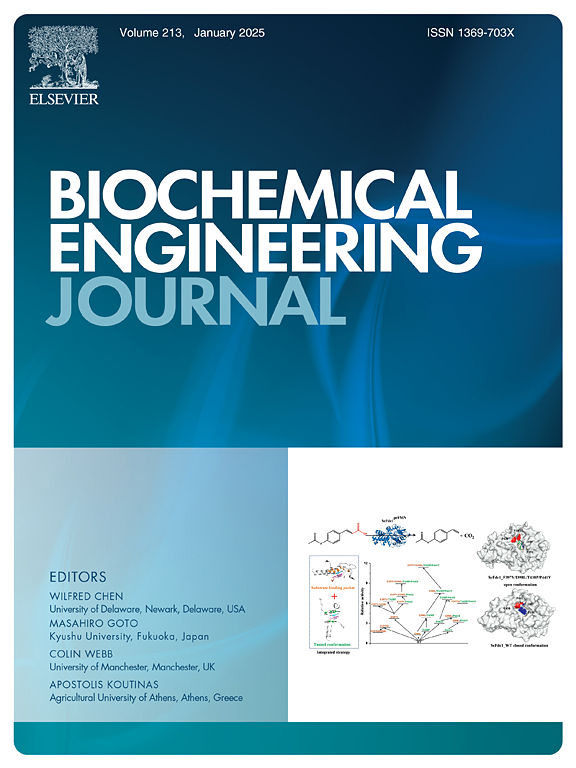粪肥再循环提高牛粪和玉米秸秆干式厌氧消化沼气产量:策略和影响
IF 3.7
3区 生物学
Q2 BIOTECHNOLOGY & APPLIED MICROBIOLOGY
引用次数: 0
摘要
对牛粪和玉米秸秆的半连续式干式厌氧消化进行了研究。以往关于干AD的研究很少探索超过60 %的消化液再循环比(R),而本研究专门研究了60 %、70 %和80 %的R值,以及20 %和25 %的总固体(TS)含量。本研究对物质平衡、微生物群落动态以及TS变化对消化液再循环效率的影响进行了综合评价。结果表明,当R = 70 %,TS = 20 %时,CH4产量最大值为1.17 L/L/d,沼气产量峰值为2.71 L/L/d。R的增加导致挥发性脂肪酸(VFAs)、总氨氮(TAN)和可溶性化学需氧量(SCOD)的积累。然而,过度的R为80 %会使沼气产量减少58.97 %。较高的TS影响不同AD阶段的物质转化效率,导致沼气和CH4产量降低,但不改变R影响的总体趋势。产气过程中,乙酰营养化甲烷菌和甲烷菌在产气过程中起着至关重要的作用,随着R的增加,甲烷菌的优势越来越明显。本文章由计算机程序翻译,如有差异,请以英文原文为准。
Digestate recirculation to enhance biogas production from dry anaerobic digestion of cow manure and corn straw: Strategies and impacts
This study investigates the semi-continuous dry anaerobic digestion (AD) of cow manure and corn straw. While previous research on dry AD rarely explored digestate recirculation ratios (R) above 60 %, this study specifically examines R values of 60 %, 70 %, and 80 %, in conjunction with total solid (TS) contents of 20 % and 25 %. The research provides a comprehensive evaluation of material balance, microbial community dynamics, and the impact of TS variation on digestate recirculation efficiency. Results show that at R = 70 % and TS = 20 %, the maximum CH4 production reaches 1.17 L/L/d, while the peak biogas production is 2.71 L/L/d. Increasing R leads to the accumulation of volatile fatty acids (VFAs), total ammonia nitrogen (TAN), and soluble chemical oxygen demand (SCOD). However, an excessively R of 80 % reduces biogas production by 58.97 %. A higher TS affects the material conversion efficiency during different AD stages, resulting in reduced biogas and CH4 production, although it does not alter the overall trend of R's influence. Acetotrophic Methanosarcina and Methanosaeta play crucial roles in biogas production, As R increases, Methanosarcina becomes increasingly dominant.
求助全文
通过发布文献求助,成功后即可免费获取论文全文。
去求助
来源期刊

Biochemical Engineering Journal
工程技术-工程:化工
CiteScore
7.10
自引率
5.10%
发文量
380
审稿时长
34 days
期刊介绍:
The Biochemical Engineering Journal aims to promote progress in the crucial chemical engineering aspects of the development of biological processes associated with everything from raw materials preparation to product recovery relevant to industries as diverse as medical/healthcare, industrial biotechnology, and environmental biotechnology.
The Journal welcomes full length original research papers, short communications, and review papers* in the following research fields:
Biocatalysis (enzyme or microbial) and biotransformations, including immobilized biocatalyst preparation and kinetics
Biosensors and Biodevices including biofabrication and novel fuel cell development
Bioseparations including scale-up and protein refolding/renaturation
Environmental Bioengineering including bioconversion, bioremediation, and microbial fuel cells
Bioreactor Systems including characterization, optimization and scale-up
Bioresources and Biorefinery Engineering including biomass conversion, biofuels, bioenergy, and optimization
Industrial Biotechnology including specialty chemicals, platform chemicals and neutraceuticals
Biomaterials and Tissue Engineering including bioartificial organs, cell encapsulation, and controlled release
Cell Culture Engineering (plant, animal or insect cells) including viral vectors, monoclonal antibodies, recombinant proteins, vaccines, and secondary metabolites
Cell Therapies and Stem Cells including pluripotent, mesenchymal and hematopoietic stem cells; immunotherapies; tissue-specific differentiation; and cryopreservation
Metabolic Engineering, Systems and Synthetic Biology including OMICS, bioinformatics, in silico biology, and metabolic flux analysis
Protein Engineering including enzyme engineering and directed evolution.
 求助内容:
求助内容: 应助结果提醒方式:
应助结果提醒方式:


